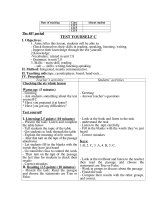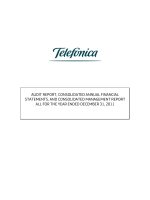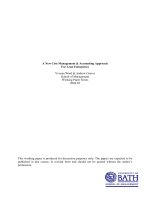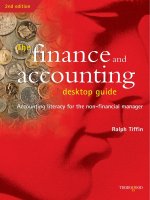An Environmental Management Accounting Model For The South African Mining Industry
Bạn đang xem bản rút gọn của tài liệu. Xem và tải ngay bản đầy đủ của tài liệu tại đây (2.1 MB, 396 trang )
AN ENVIRONMENTAL MANAGEMENT ACCOUNTING MODEL
FOR THE SOUTH AFRICAN MINING INDUSTRY
by
Maryna Möhr-Swart
Submitted in partial fulfilment of the requirements for the degree
DOCTOR TECHNOLOGIAE
in the
Department of Environmental, Water and Earth Sciences
FACULTY OF SCIENCE
TSHWANE UNIVERSITY OF TECHNOLOGY
Supervisor: Prof D S Coetzee
Co-supervisor: Prof J N Blignaut
February 2008
DECLARATION BY CANDIDATE
“I hereby declare that the thesis submitted for the degree D Tech:
Environmental Management, at Tshwane University of Technology, is my own
original work and has not been previously submitted to any other institution of
higher education. I further declare that all sources cited or quoted are
indicated and acknowledged by means of a comprehensive list of references.”
Maryna Möhr-Swart
Copyright © Tshwane University of Technology 2007
ii
This study is dedicated to
my mother Jubilie Weideman
and
my late father Jack Weideman
for their support and unconditional love.
iii
ACKNOWLEDGEMENTS
I would like to express my sincere gratitude and appreciation to:
• my two promoters, Professors Faan Coetzee and James Blignaut for their
encouragement and professional guidance
• the Chamber of Mines of South Africa and the Department of
Environmental, Water and Earth
Sciences, Tshwane University of
Technology for allowing me to complete this thesis by giving me the
support and the time needed
• Coaltech for financial assistance
• Johann Beukes, Louis du Plooy and Annalise Minnaar for their friendship,
motivation and being a crutch when I needed one
• the different mines for their support and patience, and providing the
information to make this thesis possible
• Marilyn Farguharson, my editor who taught me what an ‘em dash’ is
• Jo Grindley, the person who knows a lot more about computer
programmes than I do
• the following people who, as friends and colleagues, played a significant
role during the completion of my study: Lindie Erasmus, Ray Jansen, Nico
du Preez, Nikisi Lesufi, Babalwa Nxusani, Dick Kruger, Jaap Viljoen,
Thembi Kodisang, Marie Janse van Rensburg, Jubilie Ehlers and the
international EMA family
iv
• Seakle Godschalk, a special thanks for helping to develop the mining
framework and to make my dream come true by establishing EMAN-Africa
• Christelle Brak and Loraine van Aarde, the best friends anyone could ask
for
• the most important people in my life — my mom, Jubilie Weideman,
husband Sias and my children, Angelika and Pieter, for their love, support
and constant motivation and also their patience, and
• my Creator and Anchor in life.
Maryna Möhr-Swart
v
The fact is, if you want to save the planet, you can’t do it without
making a profit.
Steven J Bennet
Ecopreneuring,1991
vi
ABSTRACT
The mining industry in South Africa is complex. It encompasses different
types of mining operations, given the wide spectrum of operations from
underground and open cast mining to the processing of the ore. The mining
industry has become increasingly aware of the need to activate sustainable
mining operations and to reduce the environmental impacts of operations.
This realisation was specifically brought about by the changes to
environmental legislation.
Companies within the South African mining industry should recognise that
their long-term future and sustainability is inescapably linked to their ability to
reduce their environmental impacts and continuously improve their overall
environmental performance. Being aware of their environmental costs (and
benefits), company’s exposure to potential environmental problems can assist
managers in their strategic planning and help them to reduce the company’s
exposure to future environmental risks and liabilities.
There is, however, an apparent lack of documentation of and accounting for
environmental costs in a systematic and detailed manner and opportunities for
cost savings are lost. This study analyses and compares how mines are
currently managing environmental costs and how this practice could be
improved.
The main problem, which is involved in attempting to carry out systematic
identification of the potential for materials efficiency improvements lies in
vii
traditional cost accounting systems, which are unable to provide relevant
information on the company’s physical structure or materials flow.
Environmental management accounting (EMA) is able to address this
problem.
The research method followed during this project is a combination of a modelbuilding study and a comparative study, using four case studies, to compare
methods currently used by the selected mines and to refine the existing theory
and model. Obvious differences between the various case studies are the
different commodities mined and the different mining methods used.
The
results show a number of similarities between the case studies in terms of
what limitations were found in existing systems.
Results indicate certain environmental costs, for example water, energy and
consumables, were hidden; commonly accumulated in overheads by the
current accounting systems. Consequently these costs were being allocated
in a manner that did not necessarily reflect their actual use. Failure to properly
account for environmental costs meant that opportunities for improved
financial performance had been overlooked. Fairly minor or low cost changes
to existing accounting systems could lead to substantial operational
improvements.
Building on the existing EMA framework developed by the international
renowned experts, and following on the analysis of existing practices at
selected mines, a framework has been developed for the mining industry. The
viii
framework takes into account the unique characteristics of the mining
industry.
In
summary,
implementing
EMA
Environmental
performance
will
results
be
in
better
enhanced
with
decision-making.
less
negative
environmental impacts. This will have overall potential cost savings resulting
in better competitiveness and better legal compliance.
ix
INDEX
PAGE
ACKNOWLEDGEMENT ………………………………………………..
iv
ABSTRACT……………………………………………………………….
vii
LIST OF TABLES………………………………………………………...
xvi
LIST OF FIGURES……………………………………………………….
xviii
LIST OF GRAPHS………………………………………………………..
xix
GLOSSARY……………………………………………………………….
xx
1
CHAPTER 1: INTRODUCTION………………………….……..
1
1.1
Introduction………………………………………………………..
1
1.2
Background and motivation……………………………………..
2
1.3
Problem statement……………………………………………….
6
1.4
Hypothesis………………………………………………………...
6
1.5
Aim and objectives………………………………………….……
6
1.6
Previous research………………………………………………..
7
1.7
Research method…….…………………………………………..
13
1.8
Difficulties and limitation encountered during the study……...
16
1.9
Outline of the thesis………………………………………….…..
18
2
CHAPTER 2: MINING AND THE ENVIRONMENT………….
21
2.1
Introduction to mining…………………………………………….
21
2.2
Mining in South Africa……………………………………………
21
2.3
Coal and gold as natural resources…………………………….
24
2.3.1 Coal………………………………………………………………..
24
2.3.2 Gold………………………………………………………………..
27
2.3.3 Cost trend in the mining sector………………………………….
31
2.3.4 National resource accounts……………………………………..
32
2.4
Mining and processing …………..………………………………
35
2.4.1 Coal mining methods…………………………………………….
36
2.4.2 Gold mining methods…………………………………………….
38
2.4.3 Metallurgy gold plant……………………………………………..
39
x
2.5
Mining and the environment…………………………………….
39
2.5.1 Open cast mining………….……………………………………..
44
2.5.2 Underground mining…………..…………………………………
44
2.5.3 Energy consumption…..…………………………………………
45
2.5.4 Air quality………………………………………………………….
46
2.5.5 Water………………………………………………………………
47
2.5.6 Land………………………………………………………………..
49
2.5.7 Noise…………………………………………………………….…
52
2.6
Mine rehabilitation and closure.…………………………………
52
2.7
Summary…………………………………………………………..
54
3
CHAPTER 3: REGULATORY FRAMEWORK FOR MINING
IN SOUTH AFRICA………………………………………………
56
International context of the South African mining industry…..
56
3.1.1 Environmental Protection Agency………………………………
56
3.1.2 International Council on Mining and Metals…………………...
57
3.1.3 United Nations…………………………………………………….
60
3.2
International conventions and declarations……………………
62
3.2.1 Stockholm Declaration…………………………………………...
62
3.2.2 World Charter for Nature………………………………………...
63
3.2.3 Brundtland report…………………………………………………
64
3.2.4 Rio Earth Summit…………………………………………………
64
3.2.5 Johannesburg Summit…………………………………………...
65
3.2.6 Treaties and conventions………………………………………..
66
3.3
67
3.1
National context of the South African mining industry……….
3.3.1 Chamber of Mines of South Africa……………………………...
67
3.4
Legislative framework……………………………………….…...
68
3.4.1 General legislation.…………………………………………….…
74
3.4.2 Mining legislation…………………………………………….…...
76
3.4.3 Environmental legislation………………………………….…….
78
3.5
Accounting standards……………………………………………
86
3.6
Specific environmental management requirements in the
mining industry……………………………………………………
90
3.6.1 Mine closure environmental and financial issues……………..
92
xi
3.7
Summary…………………………………………………………..
97
4
CHAPTER 4: ENVIRONMENTAL MANAGEMENT……..…..
100
4.1
Introduction………………………………………………………..
100
4.2
Management in the new millennium……………………….…...
102
4.3
Environmental management ……………………………………
106
4.3.1 Environmental management drivers…………………………...
106
4.3.2 Measuring and controlling performance….……………………
108
4.3.3 Need for environmental information……………………………
110
4.4
Environmental management concepts and principles….…….
112
4.4.1 Sustainable development……………………………………….
112
4.4.2 Eco-efficiency……………………………………………………..
118
4.4.3 Cleaner production……………………………………………….
118
4.5
Environmental management tools…….………………………..
119
4.5.1 Lifecycle assessment……………………..……………………..
119
4.5.2 Environmental management systems…….……………………
122
4.5.3 Environmental impact assessment…………………………….
125
4.5.4 Environmental auditing…………………………………………..
126
4.5.5 Environmental reporting……………………….………………...
127
4.5.6 Environmental modelling………………………………………...
130
4.5.7 Environmental performance indicators………………………...
131
4.6
Environmental issues in financial accounting and reporting…
134
4.7
Environmental information and decision making……………..
135
4.8
Environmental accounting……………………………………….
136
4.9
Summary…………………………………………………………..
138
5
CHAPTER 5: ENVIRONMENTAL MANAGEMENT
ACCOUNTING ………….……………………………………….
140
5.1
Introduction………………………………………………………..
140
5.2
Accounting………………………………………………………...
141
5.3
Financial and management accounting.……………………….
142
5.4
Environmental accounting……………………………………….
144
5.4.1 Full cost accounting………………………………………………
146
xii
5.4.2 Activity-based costing……………………………………………
147
5.4.3 Total cost assessment…………………………………………...
150
5.5
Environmental costs……………………………………………...
151
5.5.1 Costs according to total cost assessment……………………..
152
5.5.2 Environmentally induced costs (assets or expenses)………..
154
5.5.3 Environmentally induced liabilities……………………………..
156
5.5.4 Environmental provisions and reserves………………………..
157
5.5.5 Capital budgeting…………………………………………………
158
5.5.6 Opportunity costs…………………………………………………
158
5.5.7 Environmental conservation cost……………………………….
159
5.5.8 Other costs description…………………………………………..
159
5.5.9 Environmental management accounting defined
environmental costs…………………………….………………..
160
5.6
The need for environmental information……………………….
165
5.7
Environmental management accounting overview……………
168
5.7.1 Defining environmental management accounting…………….
170
5.7.2 Functions and roles of environmental management
accounting…………………………………………………………
172
5.7.3 Benefits and uses of environmental management
accounting…………………………………………………………
173
5.8
Environmental management accounting methodology………
178
5.9
The business case for environmental management
accounting…………………………………………………………
183
5.10
Environmental issues in financial accounting and reporting…
185
5.11
External cost accounting………………………………………...
187
5.12
Summary…………………………………………………………..
188
6
CHAPTER 6: RESULTS………………………………………..
191
6.1
Introduction………………………………………………………..
191
6.1.1 Scope of the case studies……………………………………….
191
6.2
Case study 1: Gold……….……………………………………..
194
6.2.1 Mine A: Profile.……………………………………………….…..
194
6.2.2 Environmental cost information ………..………………….…...
195
6.2.3 Environmental Management Programme Report……….…….
208
xiii
6.2.4 Mine A general……………..……………………………………..
213
6.3
Case study 2: Coal……………………………………………….
216
6.3.1 Mine B: Profile..…………………………………………………..
216
6.3.2 Environmental cost information…………….…………………...
217
6.3.3 Environmental Management Programme Report……………..
224
6.3.4 Mine B general……………...…………………………………….
224
6.4
Case study 3: Coal ………………………………………………
228
6.4.1 Mine C: Profile..…………………………………………………..
228
6.4.2 Environmental cost information………………………..………..
229
6.4.3 Environmental Management Programme Report……………..
235
6.4.4 Mine C general..………………………………………………….
235
6.5
Case study 4: Coal.………………………………………………
238
6.5.1 Mine D: Profile..…………………………………………………..
238
6.5.2 Environmental cost information…………………………………
239
6.5.3 Environmental Management Programme Report……………..
245
6.6
Company C (Mine C and Mine D) general…………...………..
247
6.7
Key findings……………………………………………………….
250
6.8
Using EMA to improve performance……………………………
252
6.8.1 Compliance………………………………………………………..
253
6.8.2 Eco-efficiency……………………………………………………..
254
6.8.3 Strategic position…………………………………………………
254
6.9
Conclusion………………………………………………………...
254
7
CHAPTER 7: RECOMMENDATIONS AND CONCLUSION
256
7.1
Introduction ……………………………………………………….
256
7.2
Summary of chapters…………………………………………….
256
7.3
Contribution toward the mining industry in South Africa……..
258
7.3.1 Lessons learned………………………………………………….
259
7.4
Recommendations and considerations………………………...
261
7.4.1 Recommended EMA matrix……………………………………..
261
7.4.2 Recommended changes to existing accounting systems……
269
7.4.3 Implementing EMA……………………………………………….
270
7.5
270
Future Research………………………………………………….
xiv
7.6
Conclusion………………………………………………………...
273
ABREVIATION LIST……………………………………………………..
276
REFERENCES…..……………………………………………………….
278
ANNEXURE 1 Environmental management costs: questionnaire for
costs for the financial year 1991………………………
301
ANNEXURE 2 Natural resource accounts for South Africa………….
304
ANNEXURE 3 Mining process flow diagrams…………………………
309
ANNEXURE 4 Metallurgical gold plant………………………………...
312
ANNEXURE 5 International treaties and conventions important to
the South African mining industry…………………….
317
ANNEXURE 6 Environmental costs and expenditure definitions…...
321
ANNEXURE 7 Environmental costs Mine A 2001 – detail…………..
338
ANNEXURE 8 Environmental costs metallurgy – No. 9 gold plant
2001 – detail…………………………………………….
345
ANNEXURE 9 Environmental costs Mine B 2001 – detail…………..
354
ANNEXURE 10 Environmental costs Mine C 2001 – detail…………
360
ANNEXURE 11 Environmental costs Mine D 2001 – detail…………
366
xv
LIST OF TABLES
PAGE
Table 2.1
A brief history of mining in South Africa
23
Table 2.2
Gold production costs (US$) per country
29
Table 2.3
Major environmental issues in mining
41
Table 2.4
Physical, chemical and biological environmental aspects
42
and impacts of mining
Table 4.1
Comparison between two management and organisational
105
behaviour styles
Table 4.2
Industrial sustainable development indicators
114
Table 4.3
Lifecycle assessment and lifecycle cost analysis
121
approaches
Table 5.1
Summary of environmental costs, expenditures and
180
revenues
Table 5.2
Examples of distribution of environmental related costs by
182
environmental domain
Table 6.1
Mine A Summary environmental costs 2001(Rand value)
198
Table 6.2
Mine A Summary environmental costs 2001 (Percentages)
200
Table 6.3
Metallurgical plant Summary environmental costs 2001
(Rand value)
Table 6.4
204
Metallurgical plant Summary environmental costs 2001
(Rand value)
206
Table 6.5
Aspects and impact assessment for Mine A
209
Table 6.6
Relative environmental costs – Mine A (2001)
213
Table 6.7
Gold mine input-output table
214
Table 6.8
Metallurgical plant input-output table
215
Table 6.9
Mine B Summary environmental costs 2001(Rand value)
220
Table 6.10
Mine B Summary environmental costs 2001 (Percentages)
222
Table 6.11
Relative environmental costs – Mine B (2001)
225
Table 6.12
Aspects and impact assessment for Mine B
226
Table 6.13
Mine C Summary environmental costs 2001(Rand value)
230
Table 6.14
Mine C Summary environmental costs 2001 (Percentages)
232
Table 6.15
Aspects and impact assessment for Company C
236
xvi
Table 6.16
Mine D Summary environmental costs 2001(Rand value)
240
Table 6.17
Mine D Summary environmental costs 2001 (Percentages)
242
Table 6.18
Relative environmental costs – Mine C and Mine D (2001)
247
Table 7.1
Monetary value data matrix
262
Table 7.2
Physical value data matrix
265
xvii
LIST OF FIGURES
PAGE
Figure 4.1
Environmental drivers and pressures
107
Figure 4.2
The sustainable journey
116
Figure 4.3
Integrated environmental management process
124
Figure 5.1
Environmental costs summary
164
Figure 5.2
Uses and benefits of EMA
177
xviii
LIST OF GRAPHS
PAGE
Graph 2.1
Gold production total cost trends for South Africa,
30
the average of Australia, Canada and the USA and
other producers versus the gold price.
Graph 6.1
Mine A percentage costs per main cost category
196
Graph 6.2
Mine A percentage cost per environmental media
197
Graph 6.3
Metallurgical plant environmental cost percentage
per main category
Graph 6.4
Metallurgical plant environmental cost per
environmental media
Graph 6.5
Graph 6.12
239
Mine D percentage environmental costs per
environmental media
Graph 6.11
234
Mine D percentage environmental costs per main
category
Graph 6.10
229
Mine C percentage environmental costs per
environmental media
Graph 6.9
219
Mine C percentage environmental costs per main
category
Graph 6.8
218
Mine B percentage environmental costs per
environmental media
Graph 6.7
203
Mine B percentage environmental costs per main
category
Graph 6.6
202
244
Percentage environmental costs per category for all
four mines
248
Percentage environmental costs per main category
249
xix
GLOSSARY
Accounting
The process of identifying, measuring and communicating
information to permit informed judgements and decisions
by users of the information.
Activity
An event, task or unit of work with a specific purpose.
Activity based costing
Approach to costing that focuses on individual activities as
the fundamental cost objects. It uses the costs of these
activities as the basis for assigning costs to other cost
objects such as products or services.
Asset
A resource controlled by the enterprise as a result of past
events and from which future economic benefits are
expected to flow to the enterprise.
Benchmarking
The continuous process of measuring products, services or
activities against the best levels of performance.
Budget
The quantitative expression of a plan of action and an aid
to the co-ordination and implementation of the plan.
Capital budgeting
The process of making long-term planning decisions for
investments.
Contingency
A condition or situation, the ultimate outcome of which,
gain or loss, will be confirmed only on the occurrence, or
non-occurrence, of one or more uncertain future events.
Cost
Resource sacrificed or forgone to achieve a specific goal.
Cost accounting
Measures and reports financial and other information
related to the organisation’s acquisition or consumption of
resources. It provides information for both management
accounting and financial accounting.
Cost-benefit approach
Primary criterion for choosing among alternative systems
or projects, which is how each system or project achieves
organisational goals in relation to the cost thereof.
Cost driver
Any factor that affects total costs.
Design of products, The detailed planning and engineering of products,
services or processes
services or processes.
Direct costs
Costs that are related to the particular cost object and that
can be traced to it in an economically feasible way.
Direct labour costs
Compensation of all labour that is considered to be
specifically identified with the cost object and that can be
traced to it in an economically feasible way.
Direct material costs
The acquisition costs of all materials that eventually
become part of the cost object and that can be traced to it
in an economically feasible way.
xx
Eco-efficiency
The efficiency with which ecological resources are used to
meet human needs.
Effectiveness
The degree to which a predetermined objective or target is
met.
Efficiency
The relative amount of inputs used to achieve a given level
of output.
Economics
A social science concerned with how people, individually or
in groups, attempt to accommodate scarce resources to
their wants through the processes of production,
distribution, substitution, consumption and exchange.
Environment
Surroundings in which an organisation operates, including
air, water, land, natural resources, flora, fauna, humans,
and their interrelation.
Environmental aspect
Element of an organisation’s activities, products or services
that can interact with the environment.
Environmental costs
Comprise of both internal and external costs relating to all
environmental protection and environmental damage.
Environmental
economics
The application of the principles of economics to the study
of how environmental resources are developed and
managed.
Environmental impact
Any change to the environment, whether adverse of
beneficial, wholly or partially resulting from an
organisation’s activities, products or services.
Environmental
management
accounting
The management of environmental and economic
performance through the development and implementation
of appropriate environment-related accounting systems
and practices.
xxi
Environmental
management system
The part of the overall management system that includes
organisational structure, planning activities, responsibilities,
practices, procedures, processes and resources for
developing, implementing, achieving, reviewing and
maintaining the environmental policy.
Environmental policy
A statement by the organisation of its intentions and
principles in relation to its overall environmental
performance which provides a framework for action and for
setting of its environmental objectives and targets.
Expenses
Decreases in economic benefits during the accounting
period in the form of outflows or depletion of assets or
occurrences of liabilities that result in decreases in equity,
other that those relating to distributions to equity
participants.
Externalities
Externalities arise whenever the value of a production or
consumption function depends directly upon the activity of
others. Externalities are unintended or incidental.
Financial accounting
Focuses on external reporting that is guided by generally
accepted accounting principles.
Fixed cost
Cost that does not change in total despite changes in a
cost driver. Cost that remains unchanged in total for a
given period of time despite wide changes in the related
level of total activity or volume.
Impact assessment
A technical, quantitative and/or qualitative process for
classifying, characterising and assessing the effects of
resources required for production and any associated
environmental loading.
Indirect costs
Costs that are related to the particular cost object but
cannot be traced to it in an economically feasible way.
Information
Purpose oriented data.
Infrastructure costs
Costs that arise from having property, plant equipment and
a functioning organisation.
Investment
Resources or assets used to generate income.
Key success factors
Factors that directly affect customer satisfaction such as
cost, quality and time.
Lifecycle assessment
An objective process to evaluate the environmental
burdens associated with a product, process or activity by
identifying and quantifying energy and materials used and
wastes released into the environment, to assess the
impacts thereof and to evaluate and implement
opportunities to affect the environmental improvements.
Lifecycle costing
System that tracks and accumulates the actual costs
attributable to each product from start to finish.
Management
The application of accounting and financial management
xxii
accounting
principles to create, protect, preserve and increase value
as to deliver that value to stakeholders or enterprises.
Non-product
Outputs which do not leave the organisation as saleable
products e.g. waste.
All costs associated with generating revenues, other than
costs of goods sold.
Operating costs
Opportunity costs
Planning
The contribution to income that is forgone (rejected) by not
using a limited resource in its best alternative.
Choosing goals, predicting results under various ways of
achieving those goals and then deciding how to attain
these desired goals.
Prevention costs
Costs incurred to prevent defects from occurring during the
design and production of products or services.
Probability
Likelihood or chance of occurrence of an event.
Product
Any output sold to a customer that has a positive sales
value (or an output used internally that enables an
organisation to avoid incurring costs).
Production
The co-ordination and assembly of resources to produce a
product or deliver a service.
Provisions
Provisions are recognised as liabilities because they are
present obligations where it is probable that a transfer of
economic benefits will be required to settle the obligation.
Purchasing costs
Costs of goods acquired from suppliers, including freight
and transportation costs.
Qualitative factors
Outcomes that cannot be measured in numerical terms.
Quantitative factors
Outcomes that are measured in numerical terms.
Revenues
Inflow of assets received in exchange for products or
services provided to customers.
Scrap
Product that has a minimal (frequently zero) sales value.
Source documents
The original records that support entries in a system.
Stakeholders
Any individuals or groups having an interest in a company
because the can affect and/or be affected by the
company’s activities.
Standard
Carefully predetermined cost or characteristic.
xxiii
Sustainability
Society and industry should not use more natural
resources that what the natural environment can
regenerate.
Sustainable
development
Development that meets the needs of the present
generation without compromising the ability of future
generations to meet their own needs.
Total cost assessment
A decision-making tool that derives the total cost of
conducting business in a particular manner, by including
environmental costs traditionally placed into the overhead
operating budget of an organisation.
Uncertainty
The possibility that an actual amount or event will deviate
from an expected amount or event.
Unit cost
Computed by dividing some total cost (the numerator) by
some numbers of units (the denominator). Also called the
average cost.
Variable cost
Costs that change in total in proportion to changes in the
cost driver.
Variance
Differences between an actual result and a planned result.
Waste
Materials that have been purchased and paid for but which
have not been turned into marketable or saleable products.
xxiv
CHAPTER 1: INTRODUCTION
1.1
Introduction
Mining by its very nature is financially expensive, environmentally invasive
and socially intrusive, yet many countries have successfully managed to
convert their mineral endowment into national wealth, providing the country
with the economic means to address its environmental problems and social
aspirations (UNEP, 2002:7).
UNEP (2002:7) further states the mining industry (recently) has been
experiencing a spate of accidents, intense social conflicts and political debate.
In both developed and developing countries attention has been focused not
only on the mining industry as a business, but on its financiers, investors,
lenders, insurers and other stakeholders as the costs of mitigating
environmental and social damage can be enormous. Environmental, social
and, increasingly, reputational issues are just a few of the many financial risks
to be assessed by the mining industry. It is, therefore, important to assess
thoroughly environmental performance as part of the normal credit appraisal
process.
There is a growing realisation amongst environmental scientists, as stated by
various authors (Schaltegger & Burritt, 2000:54; IFAC. 2005:10; Copeland,
1999:10), that sound environmental practices can influence a company’s
profitability over the long term. This underpins the need for an investigation of
1









